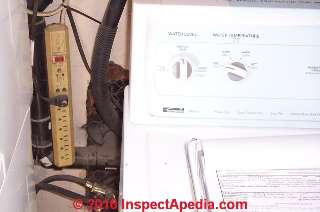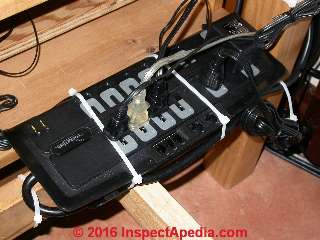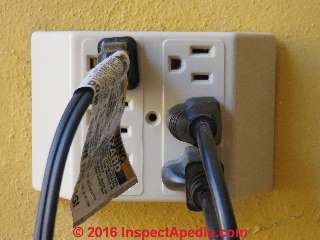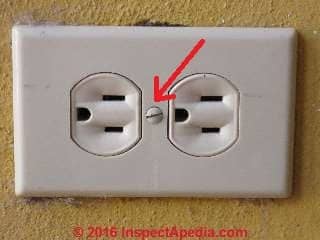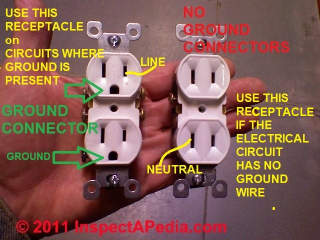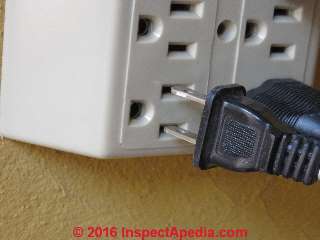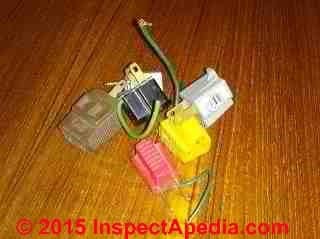 Electrical Wall Plug Adapters, Power Strips & Surge Protectors
Electrical Wall Plug Adapters, Power Strips & Surge Protectors
Safety & features of plug adapters such as three-prong plug adapters to two-prong receptacle outlets & gang adapters
- POST a QUESTION or COMMENT about wall plug adapters used at electrical outlets or receptacles in buildings.
Wall plug adapters:
Use of a three-prong adapter for two-slot electrical receptacles ("outlet" or "wall plug") when there are just two wires (hot and neutral) but no ground wire, or use of a gang adapter to expand the number of devices that can be plugged in at a single electrical receptacle is widespread but not always safe or proper.
How to choose & use a power strip or surge protector to prevent electrical equipment damage from power spikes. Use of multiple plug adapters, gang adapters, & extension cord adapters.
Dissecting a shorted-out (unsafe) wall plug gang adapter.
This article series describes how to choose, locate, wire and use an electrical receptacle in a home. Electrical receptacles (also called electrical outlets or "plugs" or "sockets") are simple devices that are easy to install, but there are details to get right if you want to be safe.
InspectAPedia tolerates no conflicts of interest. We have no relationship with advertisers, products, or services discussed at this website.
- Daniel Friedman, Publisher/Editor/Author - See WHO ARE WE?
Using Electrical Power Strips, Surge Protectors, Wall Plug Adapters
Article Contents
- ELECTRICAL WALL PLUG ADAPTERS
- SURGE PROTECTORS & POWER STRIPS
- GANG ADAPTERS
- GANG ADAPTERS on MULTIWIRE CIRCUITS
- GANG ADAPTER HIDDEN SHORT CIRCUIT
- WALL PLUG CONVERTERS - 3 prong plug into 2 prong receptacles
- WALL PLUG POLARITY
Using Electrical Power Strips for Surge Protection & to Plug In More Devices at a Single Location
Power strips such as the simple unit shown just below are a popular method for plugging in more than two electrical devices at a single wall receptacle or "outlet".
In the rather sloppy installation above this reader-contributed photo of an electrical power strip illustrates use of a power strip as a short "extension cord" to connect a clothes washing machine. The power strip may, depending on its model, also offer limited protection against electric power surges that can damage stereo equipment, computers, internet routers and other sensitive electrical equipment.
What is an electrical power surge or power spike, and why do you care?
Most of the electrical devices you may plug into a wall receptacle in your building operate at 120VAC (120 volts alternating current) or in the U.K. and some other countries at 240VAC (240 volts, alternating current). Depending on where you live, the line voltage being supplied to your building is nominally at either 120VAC or 240VAC but might vary slightly from moment to moment or during the day. In some communities line voltage may surge considerably above the nominal 120VAC / 240VAC rating to well over 300V or even higher in the event of a lightning strike or a power transformer failure.
Normal alternating current voltage is actually varying between 0 volts and about 170 volts 60 times a second. Your home appliances, computer, router, and TV are designed to operate at this power range.
During a power surge or spike, your electric lights may flicker in response: usually no harm done. But that same power surge can damage sensitive electrical equipment or even destroy it.
A typical power surge is very brief, lasting just a fraction of a second, and varying in voltage level (above the nominal power of 120V or 240V depending on where you live) from a few volts to hundreds or even thousands of volts. That very high voltage, even if just for a millisecond, is enough to burn out electrical components.
Watch out: depending on model, power strips, also often referred to simply as surge protectors, may not offer much protection against electrical power surges. Cheaper (my dad said to say "inexpensive") power strips or surge protectors are more limited in their surge protection ability or may have a shorter service life.
A better quality surge protector will typically "clamp down" a 600 volt surge in the electrical power supply down to under 200V while an inexpensive surge protector may clamp the 600V power surge to about 300V.
When buying a power strip you should be sure that yours includes surge protection. The product description will include the words "transient voltage surge suppressor", "surge protection", "surge protector", "fused power strip" or "power interrupter switch". If your product's description says only that it is a "power strip" it probably does not include this important protection.
How much surge protection you need depends on both the sensitivity of the particular electrical devices you are protecting and the frequency and sort of electrical power surges that occur where you live.
A power surge protector with a higher joule rating (e.g. 3000 joule) will provide more protection than a smaller unit. In the U.S. surge protectors sold for home use will meet UL Standard 1449, "Standard for Surge Protective Devices". That standard covers several types of surge protection devices, but all of them are:
Surge Protective Devices (SPDs) designed for repeated limiting of transient voltage surges as specified in the standard on 50 or 60 Hz power circuits not exceeding 1000 V ... - UL Standard 1449 Standard for Surge Protective Devices, retrieved 1/2/2016, original source: http://ulstandards.ul.com/standard/?id=1449
What is power surge clamping voltage? Volts vs Joules
The ability of a surge protector to protect your equipment is rated for its ability to absorb a power surge or energy surge, described as its "clamping voltage". The clamping voltage is defined as the level of voltage (over 120VAC or 240VAC) that will trigger the devices protection feature that in turn limits the voltage that can pass through to the devices plugged into it. Clamping voltage is expressed in joules (an energy rating number). If the clamping voltage of the device is over 400 Volts it's not going to offer good surge protection. You don't want to send 400 volts or more through your internet router that was rated for 120 volts.
Lower clamping voltage is better than higher clamping voltage.
But higher Joules rating for your device is better than Joules rating as Joules measures how much energy your device can safely absorb. A clamping voltage energy absorption rating of less than 600 or 700 Joules won't offer useful power surge protection, and a 3000 joule or higher clamping voltage is recommended for home use.
Watch out: the least-expensive power strips may offer no surge protection at all even if the power strip includes its own internal circuit breaker.
Watch out: some surge protectors will continue to deliver electrical power to the plugged-in devices even if its surge protection feature has worn out or failed. In that case you may not know that your electrical devices are no longer protected against power surges.
FYI: the relationship between volts and joules is volts = energy (in joules) x charge in coulombs or V = E(JO / Q (C) or Volts = Joules / Coulombs
and since most of us don't know a coulomb from a grapefruit, I'll add that coulombs combines energy and time as follows:
Coulombs = Amps x Seconds where 1 Coulomb = 1 Amp x 1 Second
We care about this time relationship because even though a power spike or surge is an event that lasts for some limited time, usually in seconds or even much less - milliseconds or nanoseconds, the ability of your power surge protector to handle this hazard has to consider both the energy level in the power surge and its duration.
Using a Power Strip or Multiple / Gang Plug Adapter to Plug in More than Two Devices at a Single Electrical Receptacle
An alternative to using a power strip (shown above) is the use of a six-plug gang adapter that plugs directly into a wall receptacle (shown below).
Using the electrical power strip shown above offers some advantages over the gang adapter, including protection from electrical power surges and the ability to plug in more than six devices.
Using the multiple wall plug adapter above has its own advantage: less clutter and a neat installation.
Is the multiple wall plug adapter shown above safe to use? Well it depends. If you overload the electrical circuit by plugging in too many high-amp devices at one location, provided the electrical circuit is properly protected by a circuit breaker or fuse, the worst that may occur is you'll trip the breaker or blow the fuse - an inconvenience but not a fire hazard.
Notice the small round hole in the center of the wall plug adapter shown above? Best practice would be to remove the original center screw holding the electrical receptacle faceplate in place (red arrow in our photo below), but leaving the plastic wall receptacle cover in place.
Next plug in the gang adapter shown above, and then install a longer center screw that will hold the gang adapter firmly in place. This improvement will prevent the accidental disconnection of all of the pugged-in devices by keeping the adapter securely fastened to the wall as you un-plug a single device.
Effects of Multiple or Gang Plug Adapters on Split-Recptacle-wired electrical circuits
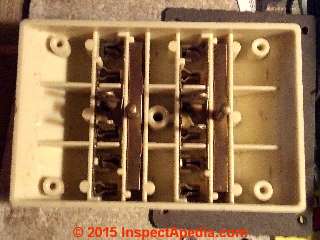 Watch out: gang plug adapters may be a convenient way to plug more than two electrical devices into an individual receptacle, but there may be electrical hazards in their use on multiwire branch circuits and there may be a safety hazard if the device wall plug is not inserted properly into the gang adapter - a mistake that is easy to make if the wall plug itself is an older non-polarized plug both of whose blades are identical in width
Watch out: gang plug adapters may be a convenient way to plug more than two electrical devices into an individual receptacle, but there may be electrical hazards in their use on multiwire branch circuits and there may be a safety hazard if the device wall plug is not inserted properly into the gang adapter - a mistake that is easy to make if the wall plug itself is an older non-polarized plug both of whose blades are identical in width
Below: a partly-disassembled gang adapter for an electrical receptacle, provided by reader D.N. [private email 2014/09/06 ] illustrates the actual electrical connections in a typical gang connector: the upper and lower receptacle trios on this device are electrically completely independent.
This means that if the adapter is plugged into a split-receptacle wired electrical receptacle on a multi-wire branch circuit, devices plugged into the upper or lower sections of the adapter should not cause multiwire branch circuit operating problems.
Reader D.N. writes:
The construction is representative of what I've found among the three such adaptors I've examined from different manufacturers. All of them, like this one, have two completely separate halves.
See MULTI-WIRE CIRCUITS for an explanation of shared-neutral electrical circuits.
Also see ELECTRICAL CONNECTIONS for 2-WIRE RECEPTACLE CIRCUIT where we discuss safety requirements for electrical receptacles on circuits where no electrical ground is present.
Hidden Short Circuit in Wall Plug Gang Adapter
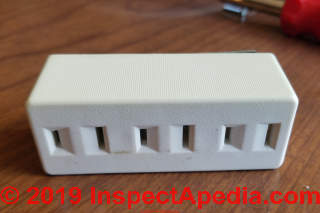 2020/03/26: We are self-quarantined in Two Harbors MN after driving up from San Miguel in our little jeep a week ago.
2020/03/26: We are self-quarantined in Two Harbors MN after driving up from San Miguel in our little jeep a week ago.
The COVID-19 virus pandemic of 2020 leads to having plenty of time for more little home projects leading in-turn to an interesting shorted electrical device discovery.
I have a stock of grounded wall receptacles that I've been gradually installing in my mother-in-law's 1960's Two Harbors home. We've looked at the successful life of the older back-wired receptacles in this home before.
This home was originally wired with un-grounded electrical receptacles or "outlets" and the family has accordingly made occasional use of multiple-plug wall adapters or "gang adapters" like the white GE™ wall plug adapter shown here.
Continuing my project of updating the wall receptacles, I replaced another of the old backwired receptacles, working carefully with power-off and as usual being meticulous, even adding a ground pigtail where needed.
Surprise: on trying to restore power the circuit breaker would not reset.
I disassembled and inspected my work - it looked perfect.
Key diagnostic question when a breaker trips
What was the last thing you did?
Key first step repair advice when a circuit breaker has tripped
Un-do it.
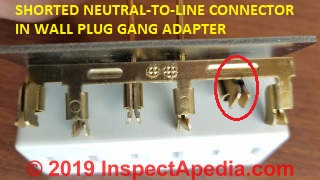 After installing the new wall receptacle, at a completely different receptacle but one on the same circuit, I had plugged-in an old multiple-plug adapter into an un-grounded receptacle that was not convenient to change-out - so that I could, using a ground-adapter, plug in the charger for my laptop.
After installing the new wall receptacle, at a completely different receptacle but one on the same circuit, I had plugged-in an old multiple-plug adapter into an un-grounded receptacle that was not convenient to change-out - so that I could, using a ground-adapter, plug in the charger for my laptop.
That was the only thing I'd done besides installing the new wall receptacle. I un-plugged it and as you've guessed, the breaker reset perfectly.
The multiple plug adapter, a white GE device that the family had in a bin of electrical supplies, is probably rather old - though exact age is unknown. A visual inspection of the adapter's exteriors shows nothing suspected. No burns, arcs, visible mechanical damage.
I took it apart - the photo below illustrates what I found.
The red circle marks the dead short, the orange circle shows that additional bending and possible contact between the hot and neutral components too.
Circled in red, the larger plug-spade connector - the neutral connector - was bent-over and literally arc-welded to the hot connector bus inside the device.
It's nice that this older GE adapter was assembled using screws, making it easy to disassemble. All of the newer devices I see are usually riveted shut.
I have no idea when this happened. But I have a plausible explanation.
Don't wiggle a wall plug when un-plugging it but that's probably not the cause of this failure
This is a family of plug-wigglers. When they are going to pull out a wall plug from the receptacle and when the fit is snug, they wiggle the plug back and forth as they pull on it. It's possible that a plug wiggler actually bent-over the internal connectors inside the adapter to cause this short.
Once the arc occurred the components are literally welded together, so plugging in this adapter anywhere results in an immediate short circuit and, fortunately, a breaker trip.
When un-plugging an electrical device at the wall plug it's best to grasp the plug firmly and pull it straight out.
Don't pull by the wire and don't wiggle the plug.
Really? Well not entirely.
Our electrical engineering forensic expert Dr. Jess Aronstein took a look at our photos and case report and commented:
Interesting sample, but I suspect that the bend of the plug blade socket contact occurred on insertion.
I can't see any way that wiggling or even yanking a plug sideways (the old vacuum cleaner story) could result in a bend like that.
If that blade contact was misaligned from the slot and a person tried very hard to insert a plug, that bend could happen.
The misalignment might have come from a sideways pull, of course. - Private email, JA to DF 2020/03/26
Is it Safe to Use a 3-Prong Adapter to Connect a 3-Pronged Appliance or Equipment Cord to a 2-Prong Ungrounded Electrical Outlet?
[Click to enlarge any image]
Reader Question: can I plug my TV into an ungrounded circuit?
5/14/2015 Chris said:
Hi, I just moved into a "new" home and all the receptacles are two-wire with no ground. Reading this, I don't believe it is safe to plug-in an adapter that ads the ground through the screw on the faceplate. However, our TV has the ground wire plug so I cannot use it.
Is here any option short of re-wiring to safely use devices that need the ground plug? Can I cut the cord on my TV and convert the plug into a two-wire style and forget the ground? (Also, we rent for now so I don't own the home). Thank you great article!
Reply:
Chris:
Do not cut or modify the cord to your TV. Doing so is unsafe and may also void the device warranty.
You are correct that it is not a good idea to connect a grounded appliance to an un-grounded electrical circuit. It is possible that there is a ground path available - you won't know until an electrician has examined your wiring.
And there are certainly three-prong adapters sold to plug into 2-prong receptacles such as the handful of them that I photographed atop this bureau in New Zealand. The 3-prong to 2-prong plug adapter typically has a tab that connects to the receptacle face plate screw - a feature that both secures the adapter in place and gives hope to the fantasy that there is an actual ground connection.
In fact there may be:
- a ground path for example may be through the three-prong adapter to two prong adapter's grounding wire or tab (see the illustration at above left),
- through the receptacle cover faceplate screw,
- through the metal strap around the receptacle to which that screw attaches
- to the metal ears that mount the receptacle to a metal (if it's metal) electrical box,
- through the screw or clamp that actually connect the receptacle mounting strap ears to the electrical box
- through the electrical box through an armored cable box clamp that secures the cable to the box,
- through the armored cable to the main electrical panel,
- through any armored cable clamps, boxes and sections that interrupt the circuit anywhere in its route between where you are using the adapter and the electrical panel (there could be many of these)
- through another cable clamp to the electrical panel box,
- through the electrical panel box itself to its grounding bus (in the panel) and
- through the grounding bus to a ground conductor that ultimately
- connects to a water pipe or grounding electrode at the property.
I gave this litany of at least a dozen connections in this makeshift electrical ground pathway to explain that if you use the adapter, your TV will probably work, and it might even have a "sort of" electrical ground. But in an unsafe situation such as a short circuit there are two hazards with this un-approved grounding approach:
1. the passage of the stray or shorted electrical current to earth has to go through multiple, potentially loose, unreliable screws, clamps, and connections that means that it may not work at all.
2. the grounded current - when it occurs - is passing not through a safe, properly-installed, code-approved grounding conductor wire but through the armored cable and other components not designed to carry current and that are exposed to touch. I watched a home owner, insisting his electrical system was safe, lick his knuckles and, standing on a damp basement floor, touch between a gas pipe and the outside of a "BX" or armored cable. He was shocked and knocked to the floor.
In sum, your TV will work, and it may be fine, in fact everything may be fine, until something isn't.
So the best approach is to install a grounded electrical circuit in the area(s) most needed, as soon as you can have that done. In the mean time if you decide to just buy and use a 3-prong to 2-prong adapter your TV will work but won't be properly protected.
Take Care to Insert the Wall Plug Into the Proper Receptacle Slots on a Gang Wall Receptacle Adapter
On a polarized wall plug the wide blade is intended to connect to the neutral wire side of the electrical receptacle and the narrow blade of the wall plug connects to the hot wire. If you are connecting a polarized wall plug (having blades of two different sizes) you cannot plug it in incorrectly.
But on a gang wall plug adapter such as the one shown below it is indeed possible to plug in a polarized wall plug in the wrong location or position on the adapter.
What happens if you plug in your wall plug into the wrong slots on the gang adapter at a receptacle?
Not much, other than wasting space at your wall plug gang adapter as long as you are using a modern wall plug whose blades are of different sizes. The wider wall plug blade will not fit into the more narrow wall plug slot and you'll be forced to insert the wall plug so that the hot and neutral wires to your device are connected properly.
However on some older devices that do not use polarized wall plugs, if you insert the wall plug as shown above you might cause reversed polarity that can damage some electrical devices such as some stereo equipment or even some coffee makers or other small appliances.
Watch out: Reversed polarity on an electrical outlet is dangerous. If you accidentally reverse these wires the device you plug in to the receptacle may "work" but it is unsafe and risks a short circuit, shock, or fire.
Details are at REVERSED POLARITY warning
Below we show the proper insertion position for a wall plug.
...
Continue reading at GROUND WIRE CONNECTIONS or select a topic from the closely-related articles below, or see the complete ARTICLE INDEX.
Or see these
Recommended Articles
- ELECTRICAL CONNECTIONS for 2-WIRE RECEPTACLE CIRCUIT
- ELECTRICAL RECEPTACLE CONNECTION DETAILS - where to connect black, white, red, green, ground wires
- ELECTRICAL WALL PLUG ADAPTERS
- GROUND WIRE CONNECTIONS
- REVERSED POLARITY warning
Suggested citation for this web page
ELECTRICAL WALL PLUG ADAPTERS at InspectApedia.com - online encyclopedia of building & environmental inspection, testing, diagnosis, repair, & problem prevention advice.
Or see this
INDEX to RELATED ARTICLES: ARTICLE INDEX to ELECTRICAL INSPECTION & TESTING
Or use the SEARCH BOX found below to Ask a Question or Search InspectApedia
Ask a Question or Search InspectApedia
Try the search box just below, or if you prefer, post a question or comment in the Comments box below and we will respond promptly.
Search the InspectApedia website
Note: appearance of your Comment below may be delayed: if your comment contains an image, photograph, web link, or text that looks to the software as if it might be a web link, your posting will appear after it has been approved by a moderator. Apologies for the delay.
Only one image can be added per comment but you can post as many comments, and therefore images, as you like.
You will not receive a notification when a response to your question has been posted.
Please bookmark this page to make it easy for you to check back for our response.
IF above you see "Comment Form is loading comments..." then COMMENT BOX - countable.ca / bawkbox.com IS NOT WORKING.
In any case you are welcome to send an email directly to us at InspectApedia.com at editor@inspectApedia.com
We'll reply to you directly. Please help us help you by noting, in your email, the URL of the InspectApedia page where you wanted to comment.
Citations & References
In addition to any citations in the article above, a full list is available on request.
- Timothy Hemm has provided photographs of various electrical defects used at the InspectAPedia TM Website. Mr. Hemm is a professional electrical inspector in Yucala, CA.
- Mark Cramer Inspection Services Mark Cramer, Tampa Florida, Mr. Cramer is a past president of ASHI, the American Society of Home Inspectors and is a Florida home inspector and home inspection educator. Mr. Cramer serves on the ASHI Home Inspection Standards. Contact Mark Cramer at: 727-595-4211 mark@BestTampaInspector.com
- John Cranor [Website: /www.house-whisperer.com ] is an ASHI member and a home inspector (The House Whisperer) is located in Glen Allen, VA 23060. He is also a contributor to InspectApedia.com in several technical areas such as plumbing and appliances (dryer vents). Contact Mr. Cranor at 804-873-8534 or by Email: johncranor@verizon.net
- [3] NFPA - the National Fire Protection Association can be found online at www.nfpa.org
- [4] The NEC National Electrical Code (ISBN 978-0877657903) - NFPA might provide Online Access but you'll need to sign in as a professional or as a visitor)
- US NEC Free Access: See up.codes at this link: https://up.codes/code/nfpa-70-national-electrical-code-2020
- [5] Special thanks to our reader Steve who pointed out prior errors in our illustrations.
- "Electrical System Inspection Basics," Richard C. Wolcott, ASHI 8th Annual Education Conference, Boston 1985.
- "Simplified Electrical Wiring," Sears, Roebuck and Co., 15705 (F5428) Rev. 4-77 1977 [Lots of sketches of older-type service panels.]
- "How to plan and install electric wiring for homes, farms, garages, shops," Montgomery Ward Co., 83-850.
- "Simplified Electrical Wiring," Sears, Roebuck and Co., 15705 (F5428) Rev. 4-77 1977 [Lots of sketches of older-type service panels.]
- "Home Wiring Inspection," Roswell W. Ard, Rodale's New Shelter, July/August, 1985 p. 35-40.
- "Evaluating Wiring in Older Minnesota Homes," Agricultural Extension Service, University of Minnesota, St. Paul, Minnesota 55108.
- Our recommended books about building & mechanical systems design, inspection, problem diagnosis, and repair, and about indoor environment and IAQ testing, diagnosis, and cleanup are at the InspectAPedia Bookstore. Also see our Book Reviews - InspectAPedia.
- In addition to citations & references found in this article, see the research citations given at the end of the related articles found at our suggested
CONTINUE READING or RECOMMENDED ARTICLES.
- Carson, Dunlop & Associates Ltd., 120 Carlton Street Suite 407, Toronto ON M5A 4K2. Tel: (416) 964-9415 1-800-268-7070 Email: info@carsondunlop.com. Alan Carson is a past president of ASHI, the American Society of Home Inspectors.
Thanks to Alan Carson and Bob Dunlop, for permission for InspectAPedia to use text excerpts from The HOME REFERENCE BOOK - the Encyclopedia of Homes and to use illustrations from The ILLUSTRATED HOME .
Carson Dunlop Associates provides extensive home inspection education and report writing material. In gratitude we provide links to tsome Carson Dunlop Associates products and services.


